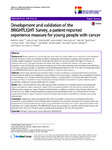Development and validation of the BRIGHTLIGHT Survey, a patient-reported experience measure for young people with cancer
| dc.contributor.author | Taylor, RM | |
| dc.contributor.author | Fern, LA | |
| dc.contributor.author | Solanki, A | |
| dc.contributor.author | Hooker, L | |
| dc.contributor.author | Carluccio, A | |
| dc.contributor.author | Pye, J | |
| dc.contributor.author | Jeans, D | |
| dc.contributor.author | Frere–Smith, T | |
| dc.contributor.author | Gibson, F | |
| dc.contributor.author | Barber, J | |
| dc.contributor.author | Raine, R | |
| dc.contributor.author | Stark, D | |
| dc.contributor.author | Feltbower, R | |
| dc.contributor.author | pearce, susie | |
| dc.contributor.author | Whelan, JS | |
| dc.date.accessioned | 2017-05-24T11:50:19Z | |
| dc.date.available | 2017-05-24T11:50:19Z | |
| dc.date.issued | 2015-12 | |
| dc.identifier.issn | 1477-7525 | |
| dc.identifier.issn | 1477-7525 | |
| dc.identifier.other | 107 | |
| dc.identifier.uri | http://hdl.handle.net/10026.1/9333 | |
| dc.description.abstract |
BACKGROUND: Patient experience is increasingly used as an indicator of high quality care in addition to more traditional clinical end-points. Surveys are generally accepted as appropriate methodology to capture patient experience. No validated patient experience surveys exist specifically for adolescents and young adults (AYA) aged 13-24 years at diagnosis with cancer. This paper describes early work undertaken to develop and validate a descriptive patient experience survey for AYA with cancer that encompasses both their cancer experience and age-related issues. We aimed to develop, with young people, an experience survey meaningful and relevant to AYA to be used in a longitudinal cohort study (BRIGHTLIGHT), ensuring high levels of acceptability to maximise study retention. METHODS: A three-stage approach was employed: Stage 1 involved developing a conceptual framework, conducting literature/Internet searches and establishing content validity of the survey; Stage 2 confirmed the acceptability of methods of administration and consisted of four focus groups involving 11 young people (14-25 years), three parents and two siblings; and Stage 3 established survey comprehension through telephone-administered cognitive interviews with a convenience sample of 23 young people aged 14-24 years. RESULT: Stage 1: Two-hundred and thirty eight questions were developed from qualitative reports of young people's cancer and treatment-related experience. Stage 2: The focus groups identified three core themes: (i) issues directly affecting young people, e.g. impact of treatment-related fatigue on ability to complete survey; (ii) issues relevant to the actual survey, e.g. ability to answer questions anonymously; (iii) administration issues, e.g. confusing format in some supporting documents. Stage 3: Cognitive interviews indicated high levels of comprehension requiring minor survey amendments. CONCLUSION: Collaborating with young people with cancer has enabled a survey of to be developed that is both meaningful to young people but also examines patient experience and outcomes associated with specialist cancer care. Engagement of young people throughout the survey development has ensured the content appropriately reflects their experience and is easily understood. The BRIGHTLIGHT survey was developed for a specific research project but has the potential to be used as a TYA cancer survey to assess patient experience and the care they receive. | |
| dc.format.extent | 0-0 | |
| dc.format.medium | Electronic | |
| dc.language | en | |
| dc.language.iso | en | |
| dc.publisher | Springer Science and Business Media LLC | |
| dc.subject | Teenager | |
| dc.subject | Young adult | |
| dc.subject | Cancer | |
| dc.subject | Experience | |
| dc.subject | BRIGHTLIGHT | |
| dc.title | Development and validation of the BRIGHTLIGHT Survey, a patient-reported experience measure for young people with cancer | |
| dc.type | journal-article | |
| dc.type | Evaluation Study | |
| dc.type | Journal Article | |
| dc.type | Research Support, Non-U.S. Gov't | |
| dc.type | Validation Study | |
| plymouth.author-url | https://www.webofscience.com/api/gateway?GWVersion=2&SrcApp=PARTNER_APP&SrcAuth=LinksAMR&KeyUT=WOS:000358472600001&DestLinkType=FullRecord&DestApp=ALL_WOS&UsrCustomerID=11bb513d99f797142bcfeffcc58ea008 | |
| plymouth.issue | 1 | |
| plymouth.volume | 13 | |
| plymouth.publication-status | Published | |
| plymouth.journal | Health and Quality of Life Outcomes | |
| dc.identifier.doi | 10.1186/s12955-015-0312-7 | |
| plymouth.organisational-group | /Plymouth | |
| plymouth.organisational-group | /Plymouth/Faculty of Health | |
| plymouth.organisational-group | /Plymouth/Faculty of Health/School of Nursing and Midwifery | |
| plymouth.organisational-group | /Plymouth/REF 2021 Researchers by UoA | |
| plymouth.organisational-group | /Plymouth/REF 2021 Researchers by UoA/UoA03 Allied Health Professions, Dentistry, Nursing and Pharmacy | |
| plymouth.organisational-group | /Plymouth/Research Groups | |
| plymouth.organisational-group | /Plymouth/Research Groups/Plymouth Institute of Health and Care Research (PIHR) | |
| plymouth.organisational-group | /Plymouth/Users by role | |
| plymouth.organisational-group | /Plymouth/Users by role/Academics | |
| dc.publisher.place | England | |
| dcterms.dateAccepted | 2015-07-22 | |
| dc.identifier.eissn | 1477-7525 | |
| dc.rights.embargoperiod | Not known | |
| rioxxterms.versionofrecord | 10.1186/s12955-015-0312-7 | |
| rioxxterms.licenseref.uri | http://www.rioxx.net/licenses/all-rights-reserved | |
| rioxxterms.licenseref.startdate | 2015-12 | |
| rioxxterms.type | Journal Article/Review |


